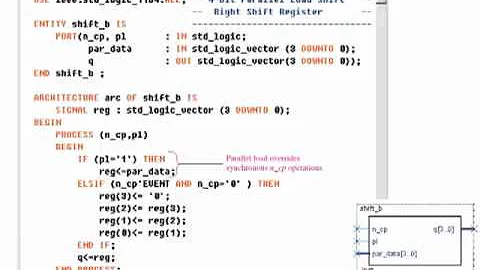VHDL shift register with enable
Solution 1
You need a two states machine to do so. Here's a very good idea of how to do it. I'm pretty sure it does what you need or is very close to.
library ieee;
use ieee.std_logic_1164.all;
entity SR is
port(
clk : in std_logic;
din : in std_logic;
rst : in std_logic;
enable : in std_logic;
sr_out : inout std_logic_vector(71 downto 0)
);
end SR;
architecture behavioral of SR is
signal shift_reg : std_logic_vector(71 downto 0);
signal shift_cnt : integer range 0 to 72 := 0;
type T_STATE_TYPE is (IDLE, COUNTING);
signal current_state : T_STATE_TYPE;
begin
p_shift_counter : process(clk,rst)
begin
if rst = '1' then
current_state <= IDLE;
shift_cnt <= 0;
elsif rising_edge(clk) then
if (current_state = IDLE) then --no enable detected yet
shift_cnt <= 0;
if enable = '1' then
current_state <= COUNTING;
end if;
elsif (current_state = COUNTING) then --will stay in that state until it finishes counting
if (shift_cnt < 72) then
shift_reg(0) <= din;
for i in 0 to 71 loop shift_reg(i+1) <= shift_reg(i); end loop; --shifting register
shift_cnt <= shift_cnt + 1;
else
current_state <= IDLE; --finished counting
end if;
end if;
end if;
end process;
sr_out <= shift_reg;
end behavioral;
Solution 2
I think you need an RS-FlipFlop which is set by a start signal. Its output is your enable signal. The start signal also starts a 72 clock cycle counter. When the counter rolls over (or reaches zero, depending on its direction) you reset the FlipFlop which results in a disabled shift register.
edit: In addition you can add a gate to the start signal which blocks new start impulses while the counter is active. So you can be sure your data is only shifted with a multiple of 72 bits.
Related videos on Youtube
user24883
Updated on June 04, 2022Comments
-
user24883 almost 2 years
I am newbie to VHDL. I am implementing serial in serial out 72 bit shift register using VHDL. When the enable signal is high, I want the shift register to shift 72 times, irrespective of whether enable continues to be high or low. I have written the following code which is working only when the enable is high. Can anyone please help me to shift data once enable is high and then does not depend on enable to shift the data?
library ieee; use ieee.std_logic_1164.all; entity SR is port(clk, din, rst, enable : in std_logic; sr_out : inout std_logic_vector(71 downto 0)); end SR; architecture behavioral of SR is signal shift_reg: std_logic_vector(71 downto 0); begin process (clk, rst) begin if (rst = '0') then shift_reg <= (others => '0'); elsif (clk'event and clk = '1') then if enable= '1' then shift_reg(70 downto 0) <= shift_reg(71 downto 1); shift_reg(71) <= din; end if; end if; end process; sr_out <= shift_reg; end behavioral;Thanks a lot!






